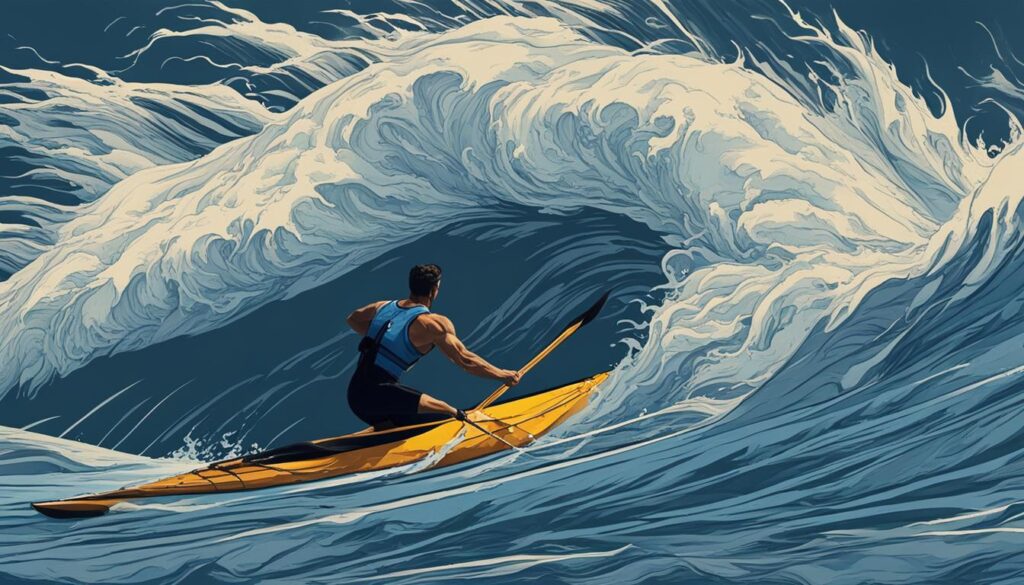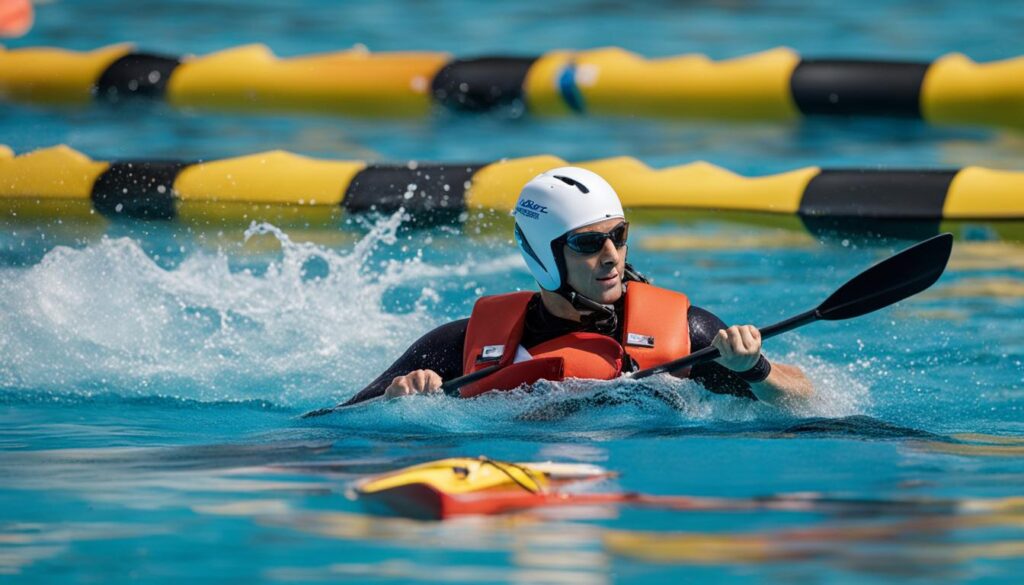If you’re looking to boost your kayak strength and transform your paddling skills, swimming is an excellent cross-training activity to incorporate into your training regimen. Multiple studies have shown the positive effects of swimming on performance in water-based sports, making it a valuable addition to any paddler’s routine.
Research has indicated that dry-land strength training exercises, such as pull-ups and bench presses, can significantly improve swimming performance. This is because swimming engages the same muscle groups used in kayaking, particularly in the upper body, which has been found to be a predictor of kayaking speed. By targeting the shoulders, back, and core, swimming helps develop the necessary strength for efficient paddling.
In addition to building strength, swimming also offers several benefits for paddlers. It provides a low-impact, full-body workout that improves cardiovascular fitness and endurance, which are essential for long kayaking sessions. Swimming also helps improve flexibility and range of motion, preventing injuries and enhancing overall performance on the water.
Key Takeaways:
- Swimming is a valuable cross-training activity for kayakers looking to enhance their strength and improve paddle performance.
- Research has indicated that dry-land strength training exercises can improve swimming performance.
- Swimming targets the muscles used in kayaking, such as the shoulders, back, and core.
- Incorporating swimming into your training routine can improve cardiovascular fitness and endurance.
- Swimming also helps improve flexibility and range of motion, preventing injuries and enhancing overall performance on the water.
Benefits of Swimming for Paddlers
Swimming offers several benefits for kayakers and paddlers. Not only does it provide a low-impact, full-body workout, but it also helps improve cardiovascular fitness and endurance, which are essential for long kayaking sessions. Swimming engages the upper body muscles used in paddling, such as the shoulders, back, and arms, leading to increased power and efficiency in kayak strokes.
Another advantage of swimming is its ability to enhance flexibility and range of motion. This improved flexibility can help prevent injuries and enhance overall performance on the water. By incorporating swimming workouts into your training routine, you can build stamina, increase endurance, and develop the necessary strength for prolonged paddling sessions.
Swimming workouts for kayakers can be further optimized by incorporating interval training and resistance exercises. Interval training, alternating between high-intensity swimming and active recovery, can simulate the bursts of power needed during kayaking, improving overall paddling stamina. Adding resistance training tools like paddles and fins can provide additional resistance and help develop specific muscle groups used in kayaking.
The Benefits of Swimming for Paddlers
- Improves cardiovascular fitness and endurance
- Strengthens upper body muscles used in paddling
- Enhances flexibility and range of motion
- Builds stamina and increases endurance
- Optimizes paddling stamina through interval training
- Develops specific muscle groups used in kayaking with resistance exercises
By incorporating swimming into your training regimen, you can significantly enhance your kayaking strength, improve paddling endurance, and ultimately transform your overall kayaking skills. So dive in today and start reaping the benefits of swimming for kayaking!
| Benefits of Swimming for Paddlers |
|---|
| Improves cardiovascular fitness and endurance |
| Strengthens upper body muscles used in paddling |
| Enhances flexibility and range of motion |
| Builds stamina and increases endurance |
| Optimizes paddling stamina through interval training |
| Develops specific muscle groups used in kayaking with resistance exercises |

Cross-Training with Swimming for Kayaking
When it comes to enhancing your kayaking strength and performance, cross-training with swimming can be an excellent addition to your training regimen. Swimming engages the same muscle groups used in kayaking, making it a targeted and effective exercise for paddlers. By incorporating swimming exercises into your routine, you can develop the specific strength and endurance needed for kayaking.
One of the key benefits of swimming for kayakers is that it helps strengthen the upper body muscles, including the shoulders, back, and arms, which are crucial for efficient paddling. Swimming laps using various strokes, such as freestyle and butterfly, can specifically target these muscles and improve their power and endurance. Additionally, drills like sculling and treading water can enhance your overall water confidence and technique.
Swimming engages the same muscle groups used in kayaking, allowing for targeted strength development.
Aquatic training, through swimming, also offers a low-impact, full-body workout that helps improve cardiovascular fitness and endurance. It provides a great opportunity to build stamina and increase your overall paddling endurance. Furthermore, swimming helps improve flexibility and range of motion, which can be crucial in preventing injuries and optimizing your performance on the water.
To make the most of your swimming workouts for kayaking, consider incorporating a variety of swim routines. Interval training, alternating between high-intensity swimming and active recovery, can help build both endurance and strength. You can also add resistance training tools, such as paddles and fins, to provide additional resistance and further develop the muscles used in kayaking.
Swim Routines for Kayaking Conditioning
Swimming is a highly effective way to condition your body for kayaking. By incorporating specific swim routines into your training program, you can target the muscles used in kayaking and improve your overall strength and endurance.
One swim routine that is beneficial for kayak muscle development is interval training. This involves alternating between periods of high-intensity swimming and active recovery. For example, you could swim 100-meter sprints at a fast pace, followed by a slower-paced 200-meter swim as recovery. This type of workout simulates the bursts of power needed during kayaking and helps build both endurance and strength.
Another effective swim routine for kayak conditioning is incorporating resistance training tools, such as paddles and fins. These tools provide additional resistance in the water, forcing your muscles to work harder. Using paddles can help develop the muscles in your arms and shoulders, while fins can target the muscles in your legs. By incorporating these tools into your swim routine, you can specifically work on the muscle groups used in kayaking and enhance your overall paddling performance.

Table: Sample Swim Routine for Kayak Muscle Development
| Exercise | Distance/Time | Intensity |
|---|---|---|
| Warm-up | 200 meters | Easy pace |
| Interval 1 | 4 x 100 meters | Fast pace |
| Recovery | 200 meters | Slow pace |
| Interval 2 | 4 x 200 meters | Moderate pace |
| Recovery | 200 meters | Slow pace |
| Interval 3 | 4 x 50 meters | Sprint pace |
| Cool-down | 200 meters | Easy pace |
This swim routine incorporates intervals of varying distances and intensity levels to simulate the demands of kayaking. It starts with a warm-up and gradually increases in intensity, allowing you to push your limits and build both endurance and strength. The recovery periods between intervals give your body a chance to rest and prepare for the next set. Finally, the cool-down helps your body recover and brings your heart rate back to normal.
By incorporating swim routines like this into your training program, you can effectively condition your body for kayaking and improve your overall muscle development, endurance, and performance on the water.
Conclusion
Swimming is a fantastic way to enhance your kayaking strength and improve your overall paddling performance. By incorporating swimming into your training regimen, you can target the specific muscles used in kayaking and develop the necessary strength for efficient paddling. Not only does swimming provide a low-impact, full-body workout, but it also improves cardiovascular fitness and endurance, which are essential for prolonged sessions on the water.
By incorporating a variety of swim routines, such as interval training and resistance exercises, you can optimize the benefits of swimming for kayaking conditioning. Interval training helps simulate the bursts of power needed during kayaking, while resistance exercises with tools like paddles and fins target specific muscle groups used in paddling. Remember to include rest days in your swim routine to allow for proper recovery and avoid overtraining.
So why wait? Dive into swim training today to enhance your kayaking strength, increase your paddling endurance, and transform your overall kayaking skills. Incorporate swimming as a cross-training activity and watch yourself become a stronger, more efficient paddler. Get ready to conquer the water with confidence and enjoy the thrill of paddling to the fullest!
FAQ
Is swimming a good cross-training activity for kayakers?
Yes, swimming is an excellent cross-training activity for kayakers. It helps enhance strength and improve paddling skills.
Which muscles does swimming target that are used in kayaking?
Swimming targets the shoulders, back, and core muscles, which are essential for efficient paddling in a kayak.
Can swimming improve cardiovascular fitness and endurance for kayaking?
Yes, swimming provides a low-impact, full-body workout that improves cardiovascular fitness and endurance, crucial for long kayaking sessions.
How can swimming help prevent injuries in kayakers?
Swimming helps improve flexibility and range of motion, which can prevent injuries and enhance overall performance on the water.
What swim routines can be incorporated for kayaking conditioning?
Interval training, incorporating high-intensity swimming and active recovery, can build endurance and strength for paddling. Using resistance training tools like paddles and fins can also help develop specific kayak muscles.





